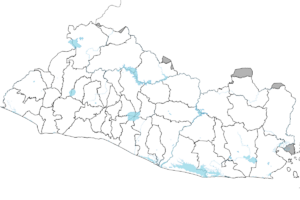Municipalities of El Salvador facts for kids
Quick facts for kids Municipio |
|
|---|---|
 |
|
| Category | Second-level administrative division |
| Location | El Salvador |
| Found in | Departments |
| Government | Municipal Council |
The municipalities (called municipios in Spanish) of El Salvador are like local government areas. They are the second main way the country is divided, after its departments. El Salvador currently has 44 municipalities.
A special law called the Municipal Code, created on January 31, 1986, explains how municipalities work. It says that a municipality is the main unit for how the government is set up in a specific area. Each municipality has its own political freedom to make decisions for its area.
On June 1, 2023, the President of El Salvador, Nayib Bukele, suggested a big change. He proposed to the Legislative Assembly that the number of municipalities should be reduced. They went from 262 down to just 44. On June 13, 2023, the Legislative Assembly agreed to this idea. These changes officially started on May 1, 2024.
Contents
A Look Back: History of Municipalities
Early Days: The Colony
The very first municipality in Central America was San Salvador. It was started in 1525 by Pedro de Alvarado. During the time when Spain ruled, they set up local councils called cabildos and ayuntamientos in the cities. These were the first forms of local government.
After Independence: New Rules
After El Salvador became independent, its first Constitution set the boundaries for each municipality. On September 4, 1832, a new rulebook was created. It was called the "Reglament of Political Governors, Municipalities and Mayors." This rulebook set the borders for departments and explained how municipalities and mayors should work.
Back then, the size of a municipal council depended on how many people lived in the area:
- If a place had 200 to 500 people, it had 1 Mayor (Alcalde), 2 Council Members (Regidores), and 1 Legal Representative (Síndico).
- For 1000 to 2000 people, there were 2 Mayors, 6 Council Members, and 2 Legal Representatives.
- If there were 2000 to 4000 people, they had 2 Mayors, 8 Council Members, and 2 Legal Representatives.
- For more than 4000 people, there were 3 Mayors, 8 Council Members, and 2 Legal Representatives.
To be part of the municipal council, you had to be a citizen, at least 25 years old, known for good behavior, and live in that municipality. Municipalities that were capital cities of districts also had to create "health boards." These boards included the First Mayor, the local priest, a Council Member, doctors, and a local resident chosen by the council. Municipalities were also in charge of keeping records and managing public projects in their area.
On December 9, 1854, the government made more changes to how municipalities were run. The number of council members changed again. Each town would have 1 Mayor and 1 Legal Representative. The number of Council Members (Regidores) now depended on the population:
- 1 Council Member for towns with up to 3000 people.
- 3 Council Members for towns with 3000 to 10,000 people.
- 5 Council Members for towns with more than 10,000 people.
This new rule also created the "Justice of the Peace" (Juzgado de Paz). This meant that legal matters were now separate from the political work of the municipalities.
Later, on November 12, 1861, President Gerardo Barrios issued another set of rules. This helped clear up confusion from many different laws about municipalities. It also made sure that municipal money was collected and used correctly.
On February 15, 1866, during President Francisco Dueñas's time, a new "Political and Municipal Code" was created. This code changed things again. It said that municipal councils would have 1 Mayor and 1 Legal Representative. The number of Council Members and Justice of the Peace judges depended on the population:
- For 200 to 2000 people, there were 2 Council Members and 1 Justice of the Peace judge (with an assistant).
- For more than 2000 people, there were 4 Council Members and 2 Justice of the Peace judges (with two assistants).
The Constitution of 1886 made sure that local government leaders were chosen by popular elections. Over the years, more laws were passed about municipalities. In 1939, the power to choose local governments went to the national executive office. But in 1945 and 1950, the municipalities got their political freedom back.
How a Municipality is Created
To create a new municipality, there are certain rules to follow. These rules are found in the Municipal Code:
- The area must have at least 50,000 people living there.
- It needs to have clear borders for its territory.
- There must be a main town with at least 20,000 people. This town will be where the local government offices are.
- The new municipality must show it can get enough money to pay for its government, administration, and important public services.
- It must fit in with the country's overall development plans.
Only the Legislative Assembly can create, combine, or add new municipalities.
How Municipalities are Organized
Municipalities are divided into different parts. There's an urban area, which is the main town or city (the municipal capital). Then there are several cantons, which are like rural districts. These cantons are made up of smaller villages called Caseríos.
See also
 In Spanish: Municipios de El Salvador para niños
In Spanish: Municipios de El Salvador para niños

